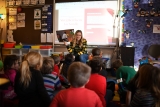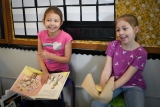-
Category 2
Selected in 2019
-
Grades: pre k - 5
School Setting: rural
Town Population: 2,950
Student Enrollment: 340
Student Demographics:
Black/African American: 1%
Teacher/Student Ratio: 1:15
White/Caucasian: 87%
Hispanic: 10%
Hawaiian/Pacific Islander: 0%
Asian: 1%
Native American: 1%
Other: 0%
% Reduced Lunch: 65%
% ELL Learners: 8%
Founded: 1968 -
PRINCIPAL:
Wayne Tuttle -
CONTACT:
452 Texas Street
Evansville, WY 82636
307-253-6400
wayne_tuttle@natronaschools.org
Evansville Elementary School
Evansville, WY
Our school's culture focuses on high expectations.
- Describe specific programs in place to ensure that families are involved in the success of your school and students.
- Professional development is another strategy that is helping us obtain big results for our students. Evansville has committed for years to develop our philosophy of constructivist math instruction. This began with working with a consultant to get a solid foundation. One of the most effective forms of professional development discovered by Hattie was peer observation. Evansville has engaged in peer observation and continual professional development. We continue to pursue ways to increase our reading achievement as we celebrate our successes in math. Our work in literacy with the University of Wyoming and attendance at CCIRA has enhanced our literacy instruction and created a focus on the continued improvement of student literacy. As we continue into the future, we will continue to collaborate and make strong professional and educational decisions while searching for best practices to allow us to continue our high levels of student achievement.
- Describe the most successful activity your school has initiated to strengthen ties to your community.
- With looping, the relationship between home and school is a two-year relationship, and the coordination for success between teachers and parents makes a huge difference. We work to engage parents in several other ways. We annually have “Power of an Hour” (parents come for one hour to observe their child) to get parents into the school and see their child in the learning environment. Parents learn things about their child they can then use at home when supporting schoolwork, and the power of this hour goes well beyond anything we could begin to track. It is foundational to our success. We also develop highly engaging family nights each month to get parents and students to learn about the work we do at school. Ten years ago, we had about 10 parents attending family nights. Now, we range in attendance between 150-300 stakeholders for each of these events, and they help us create those connections that support students
- What is the single most important factor in the success of your school that others could replicate?
- Our staff is incredible. We are committed to continuing to develop them. They are the difference-makers in the lives of our students. They will not give up on a student. Encourage them, support them and grow them. Let them have a voice in what happens at the school. They are the closest to the students.
- Describe the program or initiative that has had the greatest positive effect on student achievement, including closing achievement or opportunity gaps, if applicable.
- We send teachers to Ron Clark Academy every year. RCA is very big on student engagement. They have house structures and many of the classrooms transform the learning environment into a unique setting. Our visits there have helped us to develop the house format at our school. We have four houses, and students spin the house wheel to become members. Each house (Altuismo, Revuer, Isibindi and Amistad) represents key components that we want to teach our students: service, goals, courage, and friendship. These houses get together about once a month for common experiences. Sometimes, these experiences are Transformation Days. We transform the school and do school-wide learning in the area of STEAM, wellness, social-emotional, and literacy. We have done many themes over our three years of Transformation Days. Some of the themes include Pirate, CSI, Game, Wyoming Heritage, and Space Day. We get a lot of professional visitors and all talk about the high levels of engagement they see.
- Explain how ESEA federal funds are used to support your improvement efforts.
- Title I funds have allowed us to make wise investments in staff, professional development, learning resources, school culture, and parent-school relationships. Title I is in place to “ensure that all children have a fair, equal, and significant opportunity to obtain a high-quality education and reach, at a minimum, proficiency on challenging State academic achievement standards and state academic assessments.” Evansville Elementary has used the support of Title I funding to ensure our students have these opportunities and to empower them to succeed. Specific examples include preschool, interventionists, and professional development at RCA, CCIRA and parent-involvement evenings. For more information, please feel free to contact us.
- Describe how data is used to improve student achievement and inform decision making.
- Data is used regularly at our school to focus on student progress. We track progress toward priority standards and meet weekly in collaboration to discuss student progress. Monthly we have MTSS meetings to analyze students who need additional supports. As a building, we do root cause analysis of our major data to make sure we are continuing to progress. Our school is continually focused on improvement. Three years ago, we started a partnership with the University of Wyoming Literacy Resource Center to help support the improvement of our students’ literacy. The first year we focused on vocabulary, the second-year on informational text, and this year on writing. This partnership has created an increased focus on the literacy development of students and on our literacy professional development. This professional development opportunity has increased our professionals’ strategies for reading instruction and has resulted in overall growth in our literacy. This was all driven by our data.
- Describe your school culture and explain changes you’ve taken to improve it.
-
Our school's culture focuses on high expectations. One idea we have implemented is grade-level teams compete each year in order to earn the Eagle Cup. Each team is referred to by the year they will graduate from high school because we want to instill the expectation of graduation. In order to promote citizenship, we implemented a “Soaring Eagles Club.” Outstanding citizens receive t-shirts and receive a donated lunch from a local restaurant. These students are nominated by their teachers and voted on by each staff member. Teachers in the primary grades created a new category for their students. We have started the “Evansville Eaglet” program for K-1 students as they are “preparing to soar.” We know that not all students may reach that high standard but do very well most days. We have implemented the “I Visited the Principal Today” program. The principal calls parents daily when the student visits the principal and shares the great things he/she is doing at school.
Stats
-
Category 2
Selected in 2019
-
Grades: pre k - 5
School Setting: rural
Town Population: 2,950
Student Enrollment: 340
Student Demographics:
Black/African American: 1%
Teacher/Student Ratio: 1:15
White/Caucasian: 87%
Hispanic: 10%
Hawaiian/Pacific Islander: 0%
Asian: 1%
Native American: 1%
Other: 0%
% Reduced Lunch: 65%
% ELL Learners: 8%
Founded: 1968 -
PRINCIPAL:
Wayne Tuttle -
CONTACT:
452 Texas Street
Evansville, WY 82636
307-253-6400
wayne_tuttle@natronaschools.org










